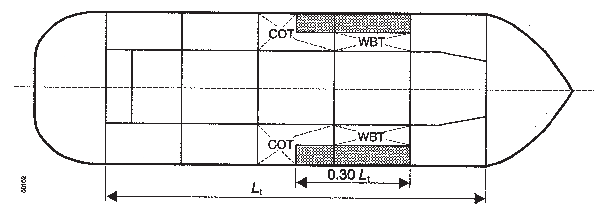.5 For the purpose of calculations, in the second
EOS number (EOS2), the tanker is assumed to have side protection only
as referred to in paragraph 4.2 of MEPC.64(36).
.6 For the purpose of calculating EOS2, hypothetical
side protection may be considered provided that the assumed positions
of the longitudinal and transverse bulkheads provide at least the
minimum side protection required by regulation
13G(4) and are placed in the locations which lead to the lowest
EOS2.
For volumes and measurement of parameters, please refer to figure 1 below.
The remaining
volumes of the tanks covered by hypothetical side protection are assumed
to carry the same type of contents as before (i.e. water ballast tanks
remain water ballast tanks and cargo oil tanks remain cargo oil tanks
in remaining part).
The size of the remaining part of
cargo oil and/or fuel oil tanks are as follows:
|
bi
|
= |
reduced if hypothetical
side protection is provided throughout the entire li. Not
modified if hypothetical side protection is provided for partial li.
|
|
Vi
|
= |
volume of cargo in the
remaining cargo oil and/or fuel oil tanks |
.7 Draft and trim requirements of MARPOL, Annex I need not be taken into account for
the purpose of calculating EOS2.
Refer to the annex.
.8 When calculating EOS2, the ship is assumed
even keel at the draft of the loaded condition corresponding to the
ship so arranged to comply with regulation
13G(4) without any consumable nor ballast.
Refer to paragraph .6 and to the annex.

Figure 1 EOS2 - volumes and measurement of parameters